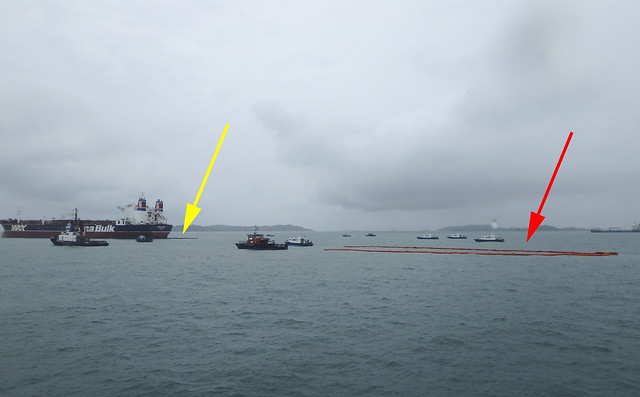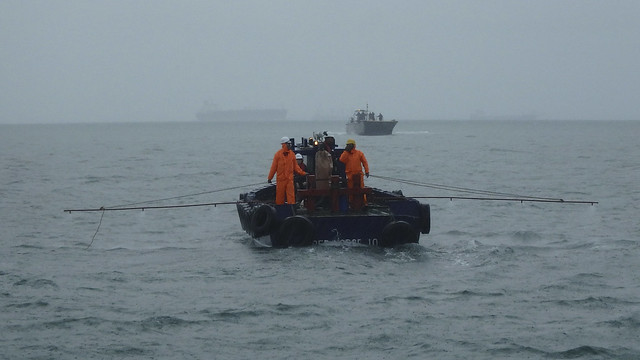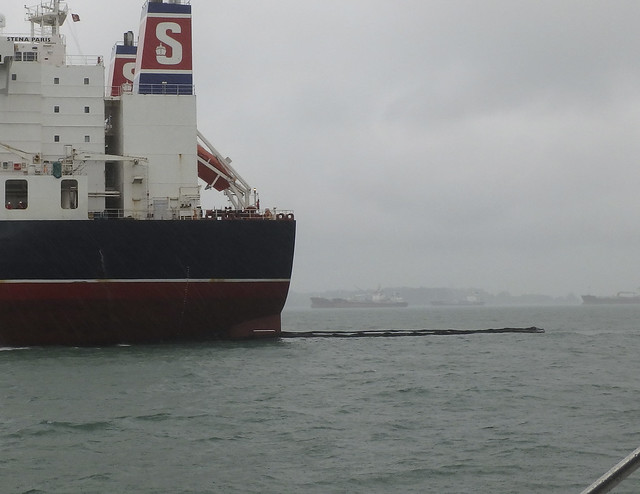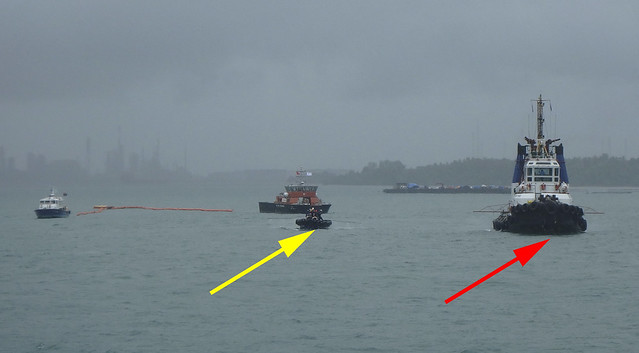 |
| We observe the evacuation of a casualty from a VLCC. |
What are dispersants?
Dispersants are basically detergent sprayed on crude oil to break them up, like using soap on greasy dishes. When the oil is dispersed into tinier bits, we don't see them but the oil is still there.
A study found that this oil-dispersant mixture is 52 times more toxic to bacteria than just the oil alone or dispersant alone. The study also found that dispersants interfered with other natural processes that degrade oil, such as effects from sunlight and ground-level ozone. Dispersants also caused sediments to absorb more of the harmful compounds, lengthening their effects on the environment.
More about the impact of dispersants
- How do the professionals deal with oil spills?
- Oil spill dispersants do more harm than good
- Oil spill at Changi East: What impact of dispersants?
- Oil spill: What long-term effects on our marine life?
- Dispersants: lessons from the Gulf oil spill
Is there a better way to deal with crude oil spills?
From an article after the massive Changi East oil spill: "The strategy to combat oil spills has remained largely unchanged over the last 30 to 40 years. The oil is either dispersed, collected or burned," said Mr Ho Yew Weng, operations manager of Oil Spill Response, in the Straits Times article.
The experts note that more efficient, less toxic and more environment-friendly types of dispersants have emerged over the years.But some experts are beginning to press for more efficient methods to deal with oil spills.
Prof Tan Soon Keat cites the use of gases like ozone instead of the usual chemical dispersants. "The oil is removed in an environmentally friendly manner as the ozone converts the oil into carbon dioxide and water". The ozone gas is saturated in water and it is sprayed on oil slicks or bubbled through seawater filled with oil globules."
What did we see at the oil spill exercise?
The JOSE 2016 exercise scenario involved a massive 10,000 metric ton spill near Raffles Lighthouse, the location of some of our best reefs, mangroves and shores in the South, and Singapore's only Southern fish farm.
Among the first things that are done is to set up a boom around the part of the stricken vessel where the oil is spilling.
We observed various kinds of vessels outfitted to spray dispersants all around the stricken vessel. Besides the smaller boat (yellow arrow), there were also larger vessels spraying dispersant (orange arrow). They were only spraying seawater during the exercise, not actual dispersant.
Among the things we were to observe was "a new modern and efficient system" called ‘NeatSweep’ which would would "funnel and concentrate" the floating oil spill and thus "drastically reduce the dispersant waste".
Here's what the system looked like on the water.
I asked why the spill gathered in ‘NeatSweep’ was not physically removed, instead of applying dispersants just to make the oil less visible, i.e., doubling the pollution (oil plus dispersant) instead of reducing the pollution (remove the oil without adding dispersant). The replies from Oil Spill Response, who own the system, was that it would be too slow to suck up the oil and there is pressure from the public, agencies and ship owners to make the oil go away quickly.
 |
| Boom around the accident vessel (yellow arrow). 'NeatSweep' nearby (orange arrow). |
Although I am still worried about first-use of dispersants, I am impressed by the "full-scale ground deployment and incident management exercise held to showcase multi-agency response capabilities."
Indeed, I feel the exercise did "serve as a platform for stakeholders to discuss and deliberate operational and policy issues to combat a major oil spill in Singapore." MPA has taken on board concerns about use of dispersants and hopes to follow up with further discussion on how best to combat a major oil spill in Singapore with a view of minimising impact to the enviroment and important installations and activities such as fish farming, desalination plants and other water intakes.
Thanks to MPA for inviting us and listening to our views.
See the MPA media release for more information about the exercise, also on wildsingapore news.
Stephen Beng also shared his thoughts and photos of the exercise on facebook.
Recent ship collisions and oil spills
- Two container ships collide while anchored off East Coast Park, 30 Sep 2016
- Ship collision near the Sisters Islands Marine Park, 3 Aug 2016
- Oil spill off Live Firing Islands, 26 Jul 2016
- Oil spill at Pulau Busing on 30 Apr 2016
- Ship collision off the Marine Park on 16 Dec 2015: no oil spill
- Oil slick at East Coast Park (12 Jul 15)
- 2 Jan 2015: Oil spill off Pedra Branca
- "Human error and poor judgement" cause of 3 oil spills in 2 weeks in Jan-Feb 2014
- Volunteers survey impact of 10 Feb oil spill
- 10 Feb 2014: Another oil spill near Sisters Islands
- Impact of Jan 2014 oil spills on Southern Islands
- Two collisions with oil spills near Southern Islands in Jan 2014
- Oil spill off East Coast Park, 2 Jul 2013
- Ship collision off Sisters Island on 2 Mar 2013: no oil spilled
- Oil spill off Sultan Shoal, Jurong Island on 9 Sep 2012
- Oil spill near Pulau Pawai, Pulau Senang 4 Jan 12
- 2,000-tonne crude oil spill off Singapore, 25 May 2010







